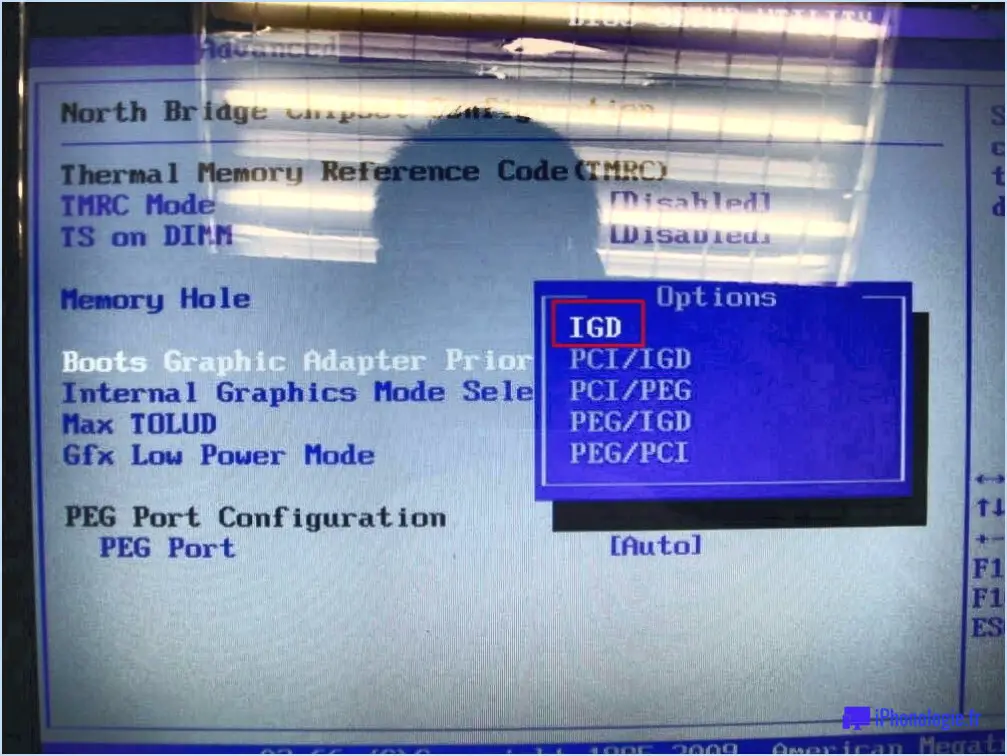What is peg pci igd in bios?

Peg PCI IGD in BIOS stands for "PCI Graphics Device." This acronym refers to a crucial component within your computer's system that enables the display of graphics. The Peg PCI IGD is responsible for facilitating the communication between the central processing unit (CPU) and the graphics card, ensuring that images and videos are rendered on your screen.
When it comes to graphics-intensive activities like gaming or watching high-definition videos, a well-functioning Peg PCI IGD is vital. It ensures smooth and seamless performance, delivering visually appealing graphics without any glitches or delays. However, if this device encounters issues or malfunctions, it can lead to visual anomalies, reduced performance, or even a complete inability to display graphics properly.
To check the status of your Peg PCI IGD in BIOS, you can access your computer's System Information window. This window provides detailed information about the hardware and software components of your system, including the status and configuration of the Peg PCI IGD. By accessing this information, you can determine if there are any problems or conflicts related to your graphics device.
Regularly monitoring the Peg PCI IGD in BIOS can be beneficial, as it allows you to stay informed about the status of your graphics device and take appropriate actions if necessary. If you encounter issues with graphics performance, updating the device drivers or adjusting the BIOS settings related to the Peg PCI IGD might be potential troubleshooting steps.
Remember that the exact steps to access the System Information window and check the Peg PCI IGD status may vary depending on your computer's manufacturer and model. Consulting the user manual or the manufacturer's website can provide specific instructions tailored to your system.
What is IGD BIOS video?
IGD BIOS video refers to a feature that enables the utilization of the integrated graphics processor (IGP) as the main graphics processor in a computer system. It functions by deactivating the discrete graphics processor, allowing the IGP to take over graphics processing duties. By utilizing the IGP as the primary graphics processor, this feature offers several benefits, including:
- Cost-effectiveness: Using the integrated graphics processor eliminates the need for a separate graphics card, resulting in cost savings.
- Power efficiency: Integrated graphics typically consume less power compared to discrete graphics cards, leading to improved energy efficiency.
- Compatibility: IGP-based systems often have better compatibility with various software and operating systems.
- Enhanced system stability: IGD BIOS video can contribute to increased system stability and reliability since the integrated graphics processor is typically more integrated with the motherboard.
By leveraging the IGP through the IGD BIOS video feature, users can optimize their computing experience with a balance of performance and cost-effectiveness.
What is peg vs PCIe?
PCIe, or Peripheral Component Interconnect Express, is a modern and advanced standard used for connecting devices to a computer. It surpasses the older PCI standard in terms of speed, flexibility, and power efficiency. With PCIe, you can achieve higher data transfer rates, making it ideal for demanding applications. It also provides greater flexibility in terms of device compatibility and configuration options. On the other hand, Peg, or PCI Express Graphics, is a legacy standard that is no longer actively developed. It offers lower speeds and less flexibility compared to PCIe. As a result, PCIe has become the preferred choice for connecting devices in modern computing systems.
What is peg and IGD?
Peg and IGD are two distinct types of diabetes, each with its own underlying causes. Peg, short for pancreatic encephalopathy-associated diabetes, is a rare form of diabetes that stems from issues within the pancreas. This condition affects the production and regulation of insulin, the hormone responsible for controlling blood sugar levels. On the other hand, IGD, or insulin-related genetic diabetes, refers to a type of diabetes that arises due to abnormalities in the body's insulin utilization. In IGD, the body may struggle to effectively use the insulin produced, leading to imbalances in blood sugar. It is crucial to differentiate between these two types of diabetes to determine the appropriate treatment and management strategies for individuals diagnosed with either condition. Understanding the underlying causes of Peg and IGD is vital for healthcare professionals to provide tailored care to patients.
What is PC IGD?
PC IGD stands for "PCI DSS Internal Governance and Data Security." It is a framework created by the PCI Security Standards Council to assist organizations in overseeing and ensuring compliance with the PCI Data Security Standard (PCI DSS). This framework aids in the management and monitoring of data security measures, internal processes, and governance practices related to payment card transactions. By implementing PC IGD, businesses can enhance their data protection efforts and minimize the risk of data breaches, thereby safeguarding sensitive cardholder information.
How do I enable graphics card in BIOS?
To enable your graphics card in BIOS, follow these steps:
- Shut down your computer completely and disconnect all power cords to ensure safety.
- Open the computer case and locate the graphics card, usually inserted into a PCI Express slot.
- Remove the screw that secures the graphics card to the case and gently pull out the card.
- Find the BIOS chip on your motherboard, typically labeled as "BIOS" or "CMOS."
- Carefully remove the BIOS chip using a chip removal tool or a sharp knife, if necessary.
- Insert the BIOS chip into a programmer device.
- Program the BIOS chip with the correct BIOS file, which can be obtained from the manufacturer's website or support.
- Once the programming is complete, remove the BIOS chip from the programmer and reinsert it into the motherboard.
- Reinstall the graphics card into the appropriate slot, securing it with the screw removed earlier.
- Close the computer case, reconnect the power cords, and power on your computer.
By following these steps, you can successfully enable your graphics card through the BIOS settings.
What is IGD memory?
IGD memory, short for Instructional Gaming and Digital Media, refers to a specific type of SDRAM utilized in video cards and graphics-intensive applications. This memory plays a crucial role in enhancing the performance of visual processing tasks. By providing high-speed data access and storage capabilities, IGD memory allows video cards to handle complex graphics rendering, enabling smoother gameplay and more immersive visual experiences. Its primary application lies in supporting instructional gaming and digital media, where real-time graphics and high-resolution displays are essential. IGD memory is an integral component for delivering optimal performance in graphics-intensive systems.
Is PCIe for graphics card?
PCIe, or Peripheral Component Interconnect Express, is not solely designed for graphics cards. Instead, it serves as a versatile interface suitable for various devices. While PCIe accommodates a wide range of peripherals, graphics cards are indeed among the most prevalent users of this technology.
The advantages of PCIe for graphics cards are numerous. Firstly, PCIe offers higher bandwidth compared to older interfaces, enabling faster data transfer between the graphics card and the system. Additionally, PCIe's scalability allows for the utilization of multiple graphics cards in a single system, promoting enhanced graphics performance and supporting technologies like NVIDIA SLI or AMD CrossFire.
Moreover, PCIe's compatibility with different system architectures, such as desktop computers, laptops, and servers, makes it an optimal choice for graphics cards across various platforms. The widespread adoption of PCIe ensures widespread compatibility and support from both hardware manufacturers and software developers.
In conclusion, while PCIe is not exclusive to graphics cards, its characteristics and benefits make it an excellent choice for graphics card connectivity in modern computing systems.
What should my integrated graphics share memory be?
To ensure smooth system performance, it is advisable for integrated graphics to share a minimal amount of memory. For the majority of systems, allocating between 256 to 512MB of memory is more than sufficient. By limiting the memory shared with integrated graphics, you allow the remaining system resources to be utilized by other tasks and applications, enhancing overall responsiveness and efficiency. Keeping this allocation conservative helps strike a balance between graphics performance and the smooth operation of your system.







